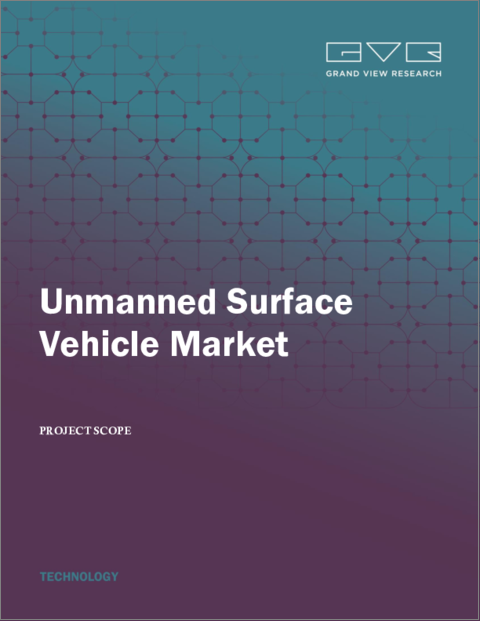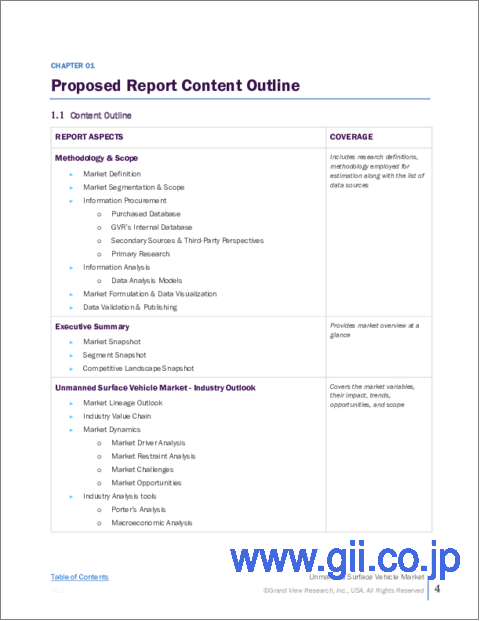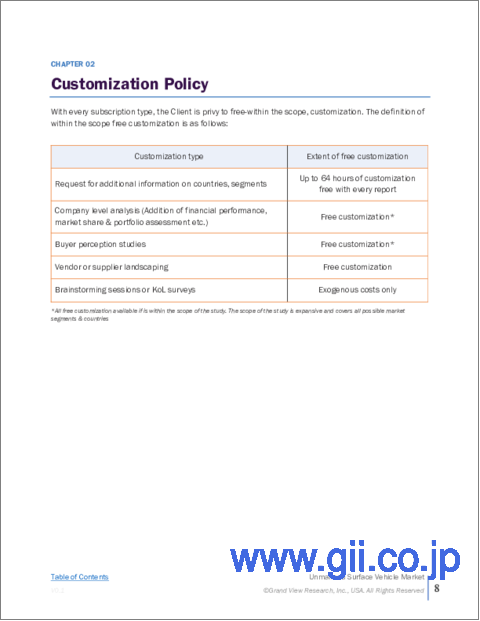|
|
市場調査レポート
商品コード
1554093
無人水上機(USV)の市場規模、シェア、動向分析レポート:タイプ別、用途別、サイズ別、地域別、セグメント予測、2024年~2030年Unmanned Surface Vehicle Market Size, Share & Trends Analysis Report By Type (Autonomous, Semi-autonomous), By Application (Defense, Commercial), By Size, By Region, And Segment Forecasts, 2024 - 2030 |
||||||
カスタマイズ可能
|
|||||||
| 無人水上機(USV)の市場規模、シェア、動向分析レポート:タイプ別、用途別、サイズ別、地域別、セグメント予測、2024年~2030年 |
|
出版日: 2024年08月13日
発行: Grand View Research
ページ情報: 英文 170 Pages
納期: 2~10営業日
|
全表示
- 概要
- 図表
- 目次
無人水上機(USV)の市場規模と動向:
無人サーフェスビークルの世界市場規模は2023年に15億8,610万米ドルとなり、2024年から2030年にかけてCAGR 11.9%で成長すると予測されています。
同市場は、防衛・安全保障用途の採用増加により大きな成長を遂げています。海軍や海上保安機関は、監視、偵察、対抗措置のために無人水上機(USV)を配備するケースが増えています。人命を危険にさらすことなく危険な環境で活動できる無人水上機(USV)の能力は、現代の海軍作戦にとって無人水上機(USV)を貴重な資産とし、その需要を促進しています。
自律航行および制御システムの技術的進歩が無人水上機(USV)市場を後押ししています。AIと機械学習の技術革新は無人水上機(USV)の能力を強化し、人間の介入を最小限に抑えて複雑な任務を遂行することを可能にしています。これらの進歩により、運用効率が向上し、運用コストが削減されるため、さまざまなエンドユーザーにとって無人水上機(USV)はより魅力的なものとなっています。
無人水上機(USV)の用途は防衛だけでなく、商業や科学研究にも広がっています。商業分野では、海洋石油・ガス探査、環境モニタリング、海洋データ収集に無人水上機(USV)の利用が拡大しています。科学研究者は、海洋学や海洋生態系の研究に無人水上機(USV)を活用しており、無人水上機(USV)の広大なエリアをカバーし、リアルタイムでデータを収集する能力の恩恵を受けています。
さらに、海上インフラと港湾のセキュリティ強化の必要性が、無人水上機(USV)市場の成長を後押ししています。港湾は、水中検査、汚染監視、警備パトロールなどの作業のために無人水上機(USV)に投資しています。無人水上機(USV)は継続的に稼働し、詳細なリアルタイムデータを提供できるため、海上インフラの維持と安全確保に不可欠なツールとなっています。
無人水上機(USV)は、ソナー、レーダー、カメラなどの高度なセンサーシステムを搭載し、その機能を強化しつつあります。これらのセンサーにより、無人水上機(USV)は水中マッピングから水面監視まで、幅広いタスクをこなすことができます。これらの高度なセンサーの統合は、意思決定プロセスに重要なデータを提供するため、さまざまな分野で無人水上機(USV)の需要を促進しています。
目次
第1章 調査手法と範囲
第2章 エグゼクティブサマリー
第3章 無人水上機(USV)市場- 業界展望
- 市場概要
- 業界バリューチェーン分析
- 市場力学
- 業界分析ツール
- 無人水上機(USV)市場- 技術動向
第4章 無人水上機(USV)市場:タイプ別推定・動向分析
- タイプ変動分析と市場シェア、2023年と2030年
- タイプ別
第5章 無人水上機(USV)市場:サイズ別推定・動向分析
- サイズ変動分析と市場シェア、2023年と2030年
- サイズ別
第6章 無人水上機(USV)市場:用途別推定・動向分析
- 用途変動分析と市場シェア、2023年と2030年
- 用途別
- 防衛
- 商業
第7章 地域別推定・動向分析
- 地域別無人水上機(USV)市場、2023年および2030年
- 北米
- 北米の無人水上機(USV)市場の推定と予測、2018-2030年
- 米国
- カナダ
- メキシコ
- 欧州
- 欧州の無人水上機(USV)市場の推定と予測、2018-2030年
- ドイツ
- 英国
- フランス
- アジア太平洋
- アジア太平洋地域の無人水上機(USV)市場の推定と予測、2018年~2030年
- 日本
- 中国
- インド
- 韓国
- オーストラリア
- ラテンアメリカ
- ラテンアメリカの無人水上機(USV)市場の推定と予測、2018年-2030年
- ブラジル
- 中東・アフリカ(中東・アフリカ)
- 中東・アフリカ無人水上機(USV)市場の推定と予測、2018-2030
- サウジアラビア
- アラブ首長国連邦
- 南アフリカ
第8章 無人水上機(USV)市場-競合情勢
- 主要市場参入企業による最近の動向と影響分析
- 企業分類
- 参入企業の概要
- 財務実績
- 製品ベンチマーク
- 企業の市場ポジショニング
- 企業ヒートマップ分析
- 戦略マッピング
- 拡大/売却
- コラボレーション/パートナーシップ
- 新製品の発売
- 研究開発
- 企業プロファイル
- ECA Group
- Elbit Systems Ltd.
- Fugro
- Kongsberg Gruppen ASA
- L3Harris Technologies, Inc.
- Liquid Robotics
- Saab AB
- Teledyne Technologies Incorporated
- Textron Systems Corporation
- Thales Group
List of Tables
- Table 1 Key market driver impact
- Table 2 Key market restraint impact
- Table 3 Unmanned Surface Vehicle (USV) Market Revenue Estimates and Forecast, By Type, 2018 - 2030 (USD Million)
- Table 4 Unmanned Surface Vehicle (USV) Market Revenue Estimates and Forecast, By Size, 2018 - 2030 (USD Million)
- Table 5 Unmanned Surface Vehicle (USV) Market Revenue Estimates and Forecast, By Application, 2018 - 2030 (USD Million)
- Table 6 Recent Developments & Impact Analysis, By Key Market Participants
- Table 7 Company Heat Map Analysis
- Table 8 Key Companies Launching New Products
- Table 9 Key Companies Pursuing Expansions
- Table 10 Key Companies Pursuing Mergers & Acquisitions
- Table 11 Key Companies Striking Collaborations/Partnerships
List of Figures
- Fig. 1 Market Segmentation And Scope
- Fig. 2 Information Procurement
- Fig. 3 Data Analysis Models
- Fig. 4 Market Formulation And Validation
- Fig. 5 Data Validating & Publishing
- Fig. 6 Market Snapshot
- Fig. 7 Segment Snapshot (1/2)
- Fig. 8 Segment Snapshot (2/2)
- Fig. 9 Competitive Landscape Snapshot
- Fig. 10 Unmanned Surface Vehicle (USV) Market - Value Chain Analysis
- Fig. 11 Unmanned Surface Vehicle (USV) Market - Market Dynamics
- Fig. 12 Unmanned Surface Vehicle (USV) Market - Porter's Five Forces Analysis
- Fig. 13 Unmanned Surface Vehicle (USV) Market - PESTEL Analysis
- Fig. 14 Unmanned Surface Vehicle (USV) Market, By Type : Key Takeaways
- Fig. 15 Unmanned Surface Vehicle (USV) Market, By Type: Market Share, 2023 & 2030
- Fig. 16 Autonomous Market Estimates & Forecasts, 2018 - 2030 (USD Million)
- Fig. 17 Semi Autonomous Market Estimates & Forecasts, 2018 - 2030 (USD Million)
- Fig. 18 Unmanned Surface Vehicle (USV) Market, By Size : Key Takeaways
- Fig. 19 Unmanned Surface Vehicle (USV) Market, By Size: Market Share, 2023 & 2030
- Fig. 20 Small Market Estimates & Forecasts, 2018 - 2030 (USD Million)
- Fig. 21 Medium Market Estimates & Forecasts, 2018 - 2030 (USD Million)
- Fig. 22 Large Market Estimates & Forecasts, 2018 - 2030 (USD Million)
- Fig. 23 Unmanned Surface Vehicle (USV) Market, By Application : Key Takeaways
- Fig. 24 Unmanned Surface Vehicle (USV) Market, By Application: Market Share, 2023 & 2030
- Fig. 25 Defense Market Estimates & Forecasts, 2018 - 2030 (USD Million)
- Fig. 26 ISR Market Estimates & Forecasts, 2018 - 2030 (USD Million)
- Fig. 27 Mine Countermeasures Market Estimates & Forecasts, 2018 - 2030 (USD Million)
- Fig. 28 Anti-ship Warfare Market Estimates & Forecasts, 2018 - 2030 (USD Million)
- Fig. 29 Communication Gateway Market Estimates & Forecasts, 2018 - 2030 (USD Million)
- Fig. 30 Others Market Estimates & Forecasts, 2018 - 2030 (USD Million)
- Fig. 31 Commercial Market Estimates & Forecasts, 2018 - 2030 (USD Million)
- Fig. 32 Weather and Environment Monitoring Market Estimates & Forecasts, 2018 - 2030 (USD Million)
- Fig. 33 Hydrographic Survey Market Estimates & Forecasts, 2018 - 2030 (USD Million)
- Fig. 34 Infrastructure Monitoring and Inspection Market Estimates & Forecasts, 2018 - 2030 (USD Million)
- Fig. 35 Others Market Estimates & Forecasts, 2018 - 2030 (USD Million)
- Fig. 36 Regional Marketplace: Key Takeaways
- Fig. 37 North America Unmanned Surface Vehicle (USV) Market Estimates & Forecast, 2018 - 2030 (USD Million)
- Fig. 38 U.S. Unmanned Surface Vehicle (USV) Market Estimates & Forecast, 2018 - 2030 (USD Million)
- Fig. 39 Canada Unmanned Surface Vehicle (USV) Market Estimates & Forecast, 2018 - 2030 (USD Million)
- Fig. 40 Mexico Unmanned Surface Vehicle (USV) Market Estimates & Forecast, 2018 - 2030 (USD Million)
- Fig. 41 Europe Unmanned Surface Vehicle (USV) Market Estimates & Forecast, 2018 - 2030 (USD Million)
- Fig. 42 Germany Unmanned Surface Vehicle (USV) Market Estimates & Forecast, 2018 - 2030 (USD Million)
- Fig. 43 UK Unmanned Surface Vehicle (USV) Market Estimates & Forecast, 2018 - 2030 (USD Million)
- Fig. 44 France Unmanned Surface Vehicle (USV) Market Estimates & Forecast, 2018 - 2030 (USD Million)
- Fig. 45 Asia Pacific Unmanned Surface Vehicle (USV) Market Estimates & Forecast, 2018 - 2030 (USD Million)
- Fig. 46 China Unmanned Surface Vehicle (USV) Market Estimates & Forecast, 2018 - 2030 (USD Million)
- Fig. 47 India Unmanned Surface Vehicle (USV) Market Estimates & Forecast, 2018 - 2030 (USD Million)
- Fig. 48 Japan Unmanned Surface Vehicle (USV) Market Estimates & Forecast, 2018 - 2030 (USD Million)
- Fig. 49 Australia Unmanned Surface Vehicle (USV) Market Estimates & Forecast, 2018 - 2030 (USD Million)
- Fig. 50 South Korea Unmanned Surface Vehicle (USV) Market Estimates & Forecast, 2018 - 2030 (USD Million)
- Fig. 51 Latin America Unmanned Surface Vehicle (USV) Market Estimates & Forecast, 2018 - 2030 (USD Million)
- Fig. 52 Brazil Unmanned Surface Vehicle (USV) Market Estimates & Forecast, 2018 - 2030 (USD Million)
- Fig. 53 MEA Unmanned Surface Vehicle (USV) Market Estimates & Forecast, 2018 - 2030 (USD Million)
- Fig. 54 Saudi Arabia Unmanned Surface Vehicle (USV) Market Estimates & Forecast, 2018 - 2030 (USD Million)
- Fig. 55 South Africa Unmanned Surface Vehicle (USV) Market Estimates & Forecast, 2018 - 2030 (USD Million)
- Fig. 56 UAE Unmanned Surface Vehicle (USV) Market Estimates & Forecast, 2018 - 2030 (USD Million)
- Fig. 57 Key Company Categorization
- Fig. 58 Componany Market Positioning
- Fig. 59 Strategic Framework
USV Market Size & Trends:
The global unmanned surface vehicle market size was valued at USD 1,586.1 million in 2023 and is expected to grow at a CAGR of 11.9 % from 2024 to 2030. The market is witnessing significant growth driven by the increasing adoption of defense and security applications. Navies and maritime security agencies are increasingly deploying unmanned surface vehicles (USV) for surveillance, reconnaissance, and countermeasures. The ability of USVs to operate in hazardous environments without risking human lives makes them an invaluable asset for modern naval operations, driving their demand.
Technological advancements in autonomous navigation and control systems are propelling the USV market. Innovations in AI and machine learning have enhanced USVs' capabilities, enabling them to perform complex missions with minimal human intervention. These advancements are improving operational efficiency and reducing the cost of operations, making USVs more attractive to various end-users.
The use of USVs is expanding beyond defense to include commercial and scientific research applications. In the commercial sector, USVs are increasingly used for offshore oil and gas exploration, environmental monitoring, and marine data collection. Scientific researchers are leveraging USVs to study oceanography and marine ecosystems, benefiting from the vehicles' ability to cover vast areas and gather data in real-time.
Moreover, the need for enhanced maritime infrastructure and port security is driving the growth of the USV market. Ports and harbors are investing in USVs for tasks such as underwater inspection, pollution monitoring, and security patrols. USVs' ability to operate continuously and provide detailed real-time data makes them an essential tool for maintaining and securing maritime infrastructure.
USVs are increasingly being equipped with advanced sensor systems, including sonar, radar, and cameras, to enhance their functionality. These sensors enable USVs to perform a wide range of tasks, from underwater mapping to surface surveillance. The integration of these advanced sensors is driving the demand for USVs in various sectors, as they provide critical data for decision-making processes.
Global Unmanned Surface Vehicle Market Report Segmentation
This report forecasts and estimates revenue growth at the global, regional, and country levels along with analyzing the latest market trends and opportunities in each one of the sub-segments from 2018 to 2030. For this study, Grand View Research has further segmented the global unmanned surface vehicle market report based on type, size, application, and region.
- Type Outlook (Revenue, USD Million, 2018 - 2030)
- Autonomous
- Semi-autonomous
- Size Outlook (Revenue, USD Million, 2018 - 2030)
- Small
- Medium
- Large
- Application Outlook (Revenue, USD Million, 2018 - 2030)
- Defense
- ISR
- Mine Countermeasures
- Anti-ship Warfare
- Communication Gateway
- Others
- Commercial
- Weather and Environment Monitoring
- Hydrographic Survey
- Infrastructure Monitoring and Inspection
- Others
- Regional Outlook (Revenue, USD Million, 2018 - 2030)
- North America
- U.S.
- Canada
- Mexico
- Europe
- Germany
- UK
- France
- Asia Pacific
- Japan
- China
- India
- Australia
- South Korea
- Latin America
- Brazil
- Middle East and Africa (MEA)
- UAE
- Saudi Arabia
- South Africa
Table of Contents
Chapter 1. Methodology and Scope
- 1.1. Market Segmentation & Scope
- 1.2. Market Definitions
- 1.3. Information Procurement
- 1.3.1. Information analysis
- 1.3.2. Market formulation & data visualization
- 1.3.3. Data validation & publishing
- 1.4. 4 Research Scope and Assumptions
- 1.4.1. List to Data Sources
Chapter 2. Executive Summary
- 2.1. Unmanned Surface Vehicle (USV) Market Snapshot
- 2.2. Unmanned Surface Vehicle (USV) Market- Segment Snapshot (1/2)
- 2.3. Unmanned Surface Vehicle (USV) Market- Segment Snapshot (2/2)
- 2.4. Unmanned Surface Vehicle (USV) Market- Competitive Landscape Snapshot
Chapter 3. Unmanned Surface Vehicle (USV) Market - Industry Outlook
- 3.1. Market Overview
- 3.2. Industry Value Chain Analysis
- 3.3. Market Dynamics
- 3.3.1. Market Driver Analysis
- 3.3.2. Market Restraint Analysis
- 3.3.3. Market Opportunity
- 3.3.4. Market Challenges
- 3.4. Industry Analysis Tools
- 3.4.1. Porter's analysis
- 3.4.2. Macroeconomic analysis
- 3.5. Unmanned Surface Vehicle (USV) Market - Technology Trends
Chapter 4. Unmanned Surface Vehicle (USV) Market: Type Estimates & Trend Analysis
- 4.1. Type Movement Analysis & Market Share, 2023 & 2030
- 4.2. Unmanned Surface Vehicle (USV) Market Estimates & Forecast, By Type (USD Million)
- 4.2.1. Autonomous
- 4.2.2. Semi-Autonomous
Chapter 5. Unmanned Surface Vehicle (USV) Market: Size Estimates & Trend Analysis
- 5.1. Size Movement Analysis & Market Share, 2023 & 2030
- 5.2. Unmanned Surface Vehicle (USV) Market Estimates & Forecast, By Size (USD Million)
- 5.2.1. Small
- 5.2.2. Medium
- 5.2.3. Large
Chapter 6. Unmanned Surface Vehicle (USV) Market: Application Estimates & Trend Analysis
- 6.1. Application Movement Analysis & Market Share, 2023 & 2030
- 6.2. Unmanned Surface Vehicle (USV) Market Estimates & Forecast, By Application (USD Million)
- 6.2.1. Defense
- 6.2.1.1. ISR
- 6.2.1.2. Mine Countermeasures
- 6.2.1.3. Anti-ship Warfare
- 6.2.1.4. Communication Gateway
- 6.2.1.5. Others
- 6.2.2. Commercial
- 6.2.2.1. Weather and Environment Monitoring
- 6.2.2.2. Hydrographic Survey
- 6.2.2.3. Infrastructure monitoring and inspection
- 6.2.2.4. Others
- 6.2.1. Defense
Chapter 7. Regional Estimates & Trend Analysis
- 7.1. Unmanned Surface Vehicle (USV) Market by Region, 2023 & 2030
- 7.2. North America
- 7.2.1. North America Unmanned Surface Vehicle (USV) Market Estimates & Forecasts, 2018 - 2030 (USD Million)
- 7.2.2. U.S.
- 7.2.3. Canada
- 7.2.4. Mexico
- 7.3. Europe
- 7.3.1. Europe Unmanned Surface Vehicle (USV) Market Estimates & Forecasts, 2018 - 2030 (USD Million)
- 7.3.2. Germany
- 7.3.3. UK
- 7.3.4. France
- 7.4. Asia Pacific
- 7.4.1. Asia Pacific Unmanned Surface Vehicle (USV) Market Estimates & Forecasts, 2018 - 2030 (USD Million)
- 7.4.2. Japan
- 7.4.3. China
- 7.4.4. India
- 7.4.5. South Korea
- 7.4.6. Australia
- 7.5. Latin America
- 7.5.1. Latin America Unmanned Surface Vehicle (USV) Market Estimates & Forecasts, 2018 - 2030 (USD Million)
- 7.5.2. Brazil
- 7.6. Middle East & Africa (MEA)
- 7.6.1. MEA Unmanned Surface Vehicle (USV) Market Estimates & Forecasts, 2018 - 2030 (USD Million)
- 7.6.2. Saudi Arabia
- 7.6.3. UAE
- 7.6.4. South Africa
Chapter 8. Unmanned Surface Vehicle (USV) Market - Competitive Landscape
- 8.1. Recent Developments & Impact Analysis, By Key Market Participants
- 8.2. Company Categorization
- 8.3. Participant's Overview
- 8.4. Financial Performance
- 8.5. Product Benchmarking
- 8.6. Company Market Positioning
- 8.7. Company Heat Map Analysis
- 8.8. Strategy Mapping
- 8.8.1. Expansion/Divestiture
- 8.8.2. Collaborations/Partnerships
- 8.8.3. New Product Launches
- 8.8.4. Research & Development
- 8.9. Company Profiles
- 8.9.1. ECA Group
- 8.9.1.1. Participant's Overview
- 8.9.1.2. Financial Performance
- 8.9.1.3. Product Benchmarking
- 8.9.1.4. Recent Developments
- 8.9.2. Elbit Systems Ltd.
- 8.9.2.1. Participant's Overview
- 8.9.2.2. Financial Performance
- 8.9.2.3. Product Benchmarking
- 8.9.2.4. Recent Developments
- 8.9.3. Fugro
- 8.9.3.1. Participant's Overview
- 8.9.3.2. Financial Performance
- 8.9.3.3. Product Benchmarking
- 8.9.3.4. Recent Developments
- 8.9.4. Kongsberg Gruppen ASA
- 8.9.4.1. Participant's Overview
- 8.9.4.2. Financial Performance
- 8.9.4.3. Product Benchmarking
- 8.9.4.4. Recent Developments
- 8.9.5. L3Harris Technologies, Inc.
- 8.9.5.1. Participant's Overview
- 8.9.5.2. Financial Performance
- 8.9.5.3. Product Benchmarking
- 8.9.5.4. Recent Developments
- 8.9.6. Liquid Robotics
- 8.9.6.1. Participant's Overview
- 8.9.6.2. Financial Performance
- 8.9.6.3. Product Benchmarking
- 8.9.6.4. Recent Developments
- 8.9.7. Saab AB
- 8.9.7.1. Participant's Overview
- 8.9.7.2. Financial Performance
- 8.9.7.3. Product Benchmarking
- 8.9.7.4. Recent Developments
- 8.9.8. Teledyne Technologies Incorporated
- 8.9.8.1. Participant's Overview
- 8.9.8.2. Financial Performance
- 8.9.8.3. Product Benchmarking
- 8.9.8.4. Recent Developments
- 8.9.9. Textron Systems Corporation
- 8.9.9.1. Participant's Overview
- 8.9.9.2. Financial Performance
- 8.9.9.3. Product Benchmarking
- 8.9.9.4. Recent Developments
- 8.9.10. Thales Group
- 8.9.10.1. Participant's Overview
- 8.9.10.2. Financial Performance
- 8.9.10.3. Product Benchmarking
- 8.9.10.4. Recent Developments
- 8.9.1. ECA Group






